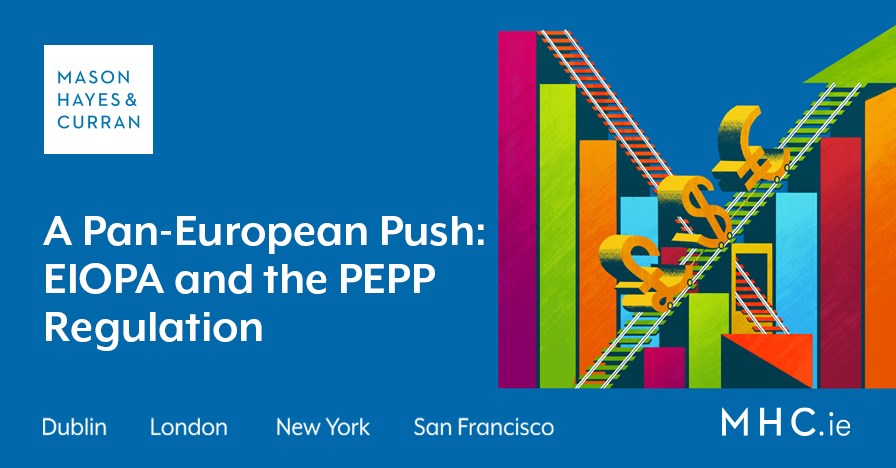
The PEPP Regulation
The Regulation establishes a legal foundation for a PEPP market by ensuring the standardisation of the product’s features. It provides a set of uniform rules that will apply to all PEPPs created in every Member State. The rules cover authorization, manufacturing, distribution as well as supervision. The product will allow members to switch providers, both domestically and cross-border, at a capped cost every five years. This will allow members to take their pension with them when moving between Member States. This portability function is central to the PEPP. Much like the IORP II Directive and the Supplementary Pension Rights Regulations, the PEPP regulation’s aim is to promote worker mobility and job creation across the EU and assist in further developing the Capital Markets Union.
EIOPA: Recent Work
EIOPA have presented the European Commission with a set of draft regulatory and implementing technical standards. These were based upon recent public consultations. To allow for comparability between PEPPs, EIOPA has also published two mandatory consumer information documents; a PEPP key information document (KID) and a PEPP benefit statement (Benefit Statement).
The KID will set out the investment options for the PEPP. It will also include a 'summary risk indicator' that identifies the riskiness of the different PEPP investment options. The Benefit Statement will enable members to monitor the value of their PEPP. The KID and the Benefit Statement will allow consumers to easily compare the key elements of each PEPP to make a well-informed decision.
Tax
Tax is not referred to in any detail in the technical standards documents provided by EIOPA. In a tax recommendation issued in June 2017, the Commission encouraged Member States to grant PEPPs the same tax treatment as national pension products. In practical terms, the Commission is expecting Member States to exchange best practices on tax treatment of the PEPP to create a level playing field. However, there is no express provision in the legal instruments to ensure that this will occur.
The potential for the PEPP in Ireland
The aim of the PEPP is to introduce a cost efficient, secure and portable pension product into the European pensions and insurance markets. The annual cost of the “Basic PEPP” is to be limited to 1% of the PEPP’s accumulated capital at the end of each year. The Basic PEPP will be the default investment option and is structured to allow for a strong level of capital protection. There is also an option to extend the level of protection by way of a capital guarantee. The cost of the guarantee will be excluded from the overall cost cap though disclosed at the outset.
While some Member States have very few single member pension options, Ireland has a range of existing products. The product most similar to the PEPP in the Irish market is undoubtedly the PRSA. The PRSA is flexible and portable and does not have the same switching and investing restrictions that are present in the PEPP. While the PRSA does not benefit from an EU passport, there is no uncertainty in respect of its tax benefits. PEPP investment rules also prevent the holder from investing 100% in property, whereas such an investment choice is permitted by a non-Standard PRSA. PEPP providers may levy a transfer charge of up to 1.5% on transfer to another PEPP. In contrast, providers are legally prohibited from applying a charge on a transfer from one PRSA to another. Given the existing options available to Irish pension savers as well as the in-built levels of capital protection required for the PEPP, it remains to be seen whether Irish pension providers will see it as an attractive product.
Supervision
Each national authority will be responsible for authorising PEPPs. EIOPA’s role will include product intervention powers at the EU-level. EIOPA will also be responsible for the development of technical standards. It is expected that the success of the PEPP will require a significant amount of cooperation between national authorities across Member States. While such cooperation may be common in the funds industry, it is very much new territory for pensions.
Conclusion
PEPPs are likely to be very popular given their simplicity, transparency and portability. It is hoped that the product will assist in reaching the very large portion of workers across the EU that are currently not enrolled in a pension plan, with some estimates as high as 25% of Europeans in the 25 to 59 age bracket. If it proves to be popular with pension savers, it is likely that the PEPP will add greater depth and liquidity to capital markets. This in turn will create jobs and stimulate growth. The PEPP still faces some challenges in the form of existing national regimes, competing products and clarity on its tax treatment across all Member States. In looking at costs, a standard PRSA charge cannot be greater than 5% of each contribution and 1% per annum of the fund value. However, unlike the PEPP, an owner of a standard PRSA may switch provider at any time and without incurring a charge for switching.
For further information regarding compliance with the IORP II Directive, contact a member of our Pensions team.
The content of this article is provided for information purposes only and does not constitute legal or other advice.
Share this:






